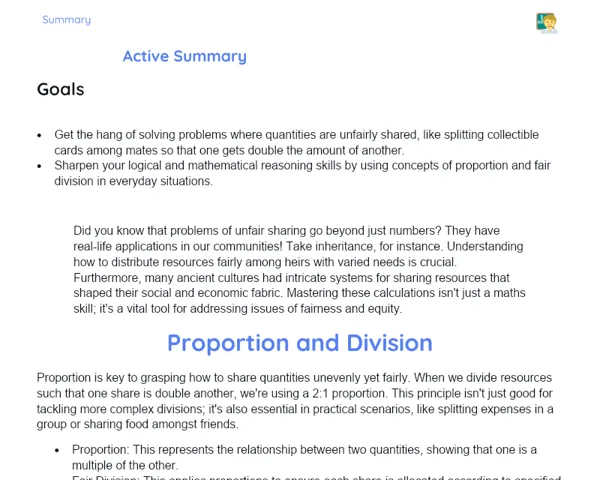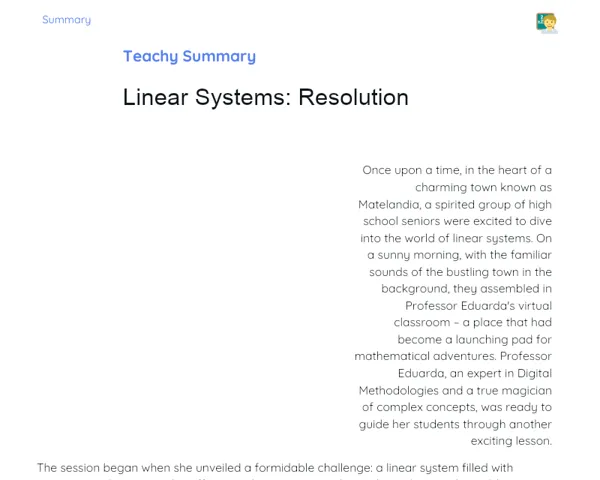Summary Tradisional | Data Interpretation
Contextualization
We live in a world overflowing with information, where we're constantly hit with data from various channels such as news, social media, academic research, and even our daily chats. This data comes in all sorts of formats, like tables, graphs, and diagrams. Being able to interpret this data is key to grasping what's happening around us and making well-informed decisions.
Data interpretation is a vital skill in many aspects of our lives. For example, marketing companies rely on research data to gain insights into consumer behaviour, poring over graphs and tables to find out which products are flying off the shelves and which ads hit the mark. In environmental contexts, data analysis around recycling and responsible consumption aids us in refining our sustainable practices.
To Remember!
Importance of Data Interpretation
The skill to interpret data is essential for understanding information presented in various formats like graphs, tables, and diagrams. In today’s age, where we're frequently inundated with data, the ability to make sense of it is critical for informed decision-making. Whether in a classroom setting or everyday life, being able to interpret data helps us to spot trends, patterns, and exceptions, which leads to a better understanding of complex situations.
Furthermore, data interpretation is integral to numerous professional sectors. Businesses use data to inform their marketing strategies, governments rely on it for policy-making, and scientists depend on it to validate their research. Thus, being adept at reading and interpreting data can pave the way for opportunities in various career paths.
In the educational sphere, acquiring data interpretation skills is woven into multiple subjects, especially Mathematics, where graphs and tables are common tools for conveying information. Fostering these skills from a young age arms students with the capability to tackle complex data and make evidence-based decisions.
-
Comprehending information through graphs, tables, and diagrams.
-
Making informed decisions based on data analysis.
-
Applicability across various professional and academic domains.
Types of Graphs
There are several graph types used to depict data, each serving a unique purpose. Bar graphs are perfect for comparing quantities across different categories; they’re straightforward and a popular choice for categorical data representation. Line graphs are excellent for illustrating trends over time, as they link data points with lines, making it easier to see changes and trends.
Pie charts, or sector graphs, are designed to show the proportional distribution of a dataset. Each slice represents part of the whole, making it easier to visualize percentages and proportions. These charts are particularly handy when aiming to highlight the relative contributions of different categories within a dataset.
Choosing the right type of graph is vital for conveying the intended message. The appropriate graph can enhance understanding and interpretation of the data, while a poor choice can obscure the information and complicate analysis.
-
Bar graphs for comparing quantities among categories.
-
Line graphs for illustrating trends over time.
-
Pie charts for showcasing proportional distributions.
Data Tables
Tables are a practical way to organize and present data systematically. They enable the visualization of large volumes of information in a neat and ordered fashion. In a table, data is arranged in rows and columns, which simplifies direct comparisons between different datasets.
Reading a table accurately requires understanding the headers for rows and columns, which denote the categories and variables of the displayed data. The ability to pinpoint crucial information from a table is essential for data interpretation. For example, a table might reveal the amount of waste recycled over several months, enabling us to analyse fluctuations over time.
Tables are also excellent for synthesizing and summarizing complex data. They can be employed to calculate averages, totals, and other critical statistics, providing a clear and objective snapshot of the presented information.
-
Structured organization and presentation of data.
-
Facilitating comparisons between different datasets.
-
Summarizing and synthesizing complex information.
Data Analysis
Data analysis entails examining and interpreting data to uncover trends, patterns, and anomalies. This practice is crucial for turning raw data into valuable and actionable information. Data analysis can be beneficial in many contexts, from scrutinizing product sales to evaluating environmental data.
To analyze data effectively, it is vital to utilize the right tools and techniques. Graphs and tables are essential instruments that assist in visualizing and interpreting data. Moreover, implementing statistical calculations like averages and standard deviations can help pinpoint trends and notable variations in the data.
Data analysis also embodies the ability to pose critical questions concerning the data presented. For instance, while assessing a sales graph, one might inquire about the factors that contributed to sales variations over time. This analytical approach is indispensable for precise and informed data interpretation.
-
Examine and interpret data to detect trends and anomalies.
-
Apply appropriate tools and techniques for data analysis.
-
Pose critical questions about the data presented.
Synthesis of Conclusions
The synthesis of conclusions involves summarizing and delivering the main findings from a data analysis clearly and concisely. This requires pinpointing the most important information and connecting key points logically. The proficiency to synthesize conclusions is vital for effectively communicating the outcomes of an analysis.
To synthesize conclusions well, it’s important to concentrate on the most significant data while steering clear of extraneous details. Using graphs and tables effectively can aid in emphasizing the main points and facilitating the understanding of the conclusions. Additionally, clarity in writing and organization of the presentation is crucial to ensure comprehensibility of the conclusions.
The ability to synthesize conclusions is a valuable skill across several fields, including education, business, and scientific research. It enables the efficient sharing of analysis results, supporting informed and evidence-based decision-making.
-
Summarize and present the main findings of data analysis.
-
Focus on the most significant data and avoid extraneous details.
-
Utilize graphs and tables to underscore key points.
Key Terms
-
Data Interpretation: The ability to comprehend and analyse information presented in graphs, tables, and diagrams.
-
Bar Graphs: A graphic representation of categorical data using bars to compare quantities.
-
Line Graphs: Graphs that connect data points with lines to illustrate trends over time.
-
Pie Charts: Graphs that display the proportional distribution of a dataset in sectors.
-
Data Tables: A format for organizing and presenting data in rows and columns.
-
Data Analysis: The process of examining and interpreting data to identify trends, patterns, and anomalies.
-
Synthesis of Conclusions: The process of summarizing and presenting the key findings of a data analysis in a clear and concise manner.
Important Conclusions
In this lesson, we explored the significance of data interpretation, highlighting how this skill is essential in understanding information presented through graphs, tables, and diagrams. We looked at various graph types—such as bar, line, and pie charts—and their specific applications for clear and effective data representation. We also delved into how to read and interpret data tables, extracting vital information and synthesising conclusions from data analysis.
The ability to interpret data is crucial in both academic settings and daily life, enabling us to make informed and well-founded decisions. Companies, governments, and researchers utilize data analysis to shape strategies, formulate public policies, and substantiate research. Cultivating this skill from an early age equips students to confront complex challenges and embrace opportunities in various professional landscapes.
Moreover, synthesising conclusions is a cherished competency that aids in communicating analysis results clearly and concisely. By mastering data interpretation and analysis, students will enhance their understanding of the world around them and contribute meaningfully in their future careers and areas of study.
Study Tips
-
Review the examples of graphs and tables presented in class and attempt creating your own graphs using data from your personal interests or current events. This will strengthen your understanding of different graph types and their applications.
-
Practice data analysis utilizing various sources—like news articles, scholarly papers, and company reports. Pose critical questions regarding the presented data and explore identifying trends, patterns, and anomalies.
-
Leverage digital tools, like spreadsheets, to organize and analyse data. Experiment with various graph and table types for representing data and synthesising clear and concise conclusions.



